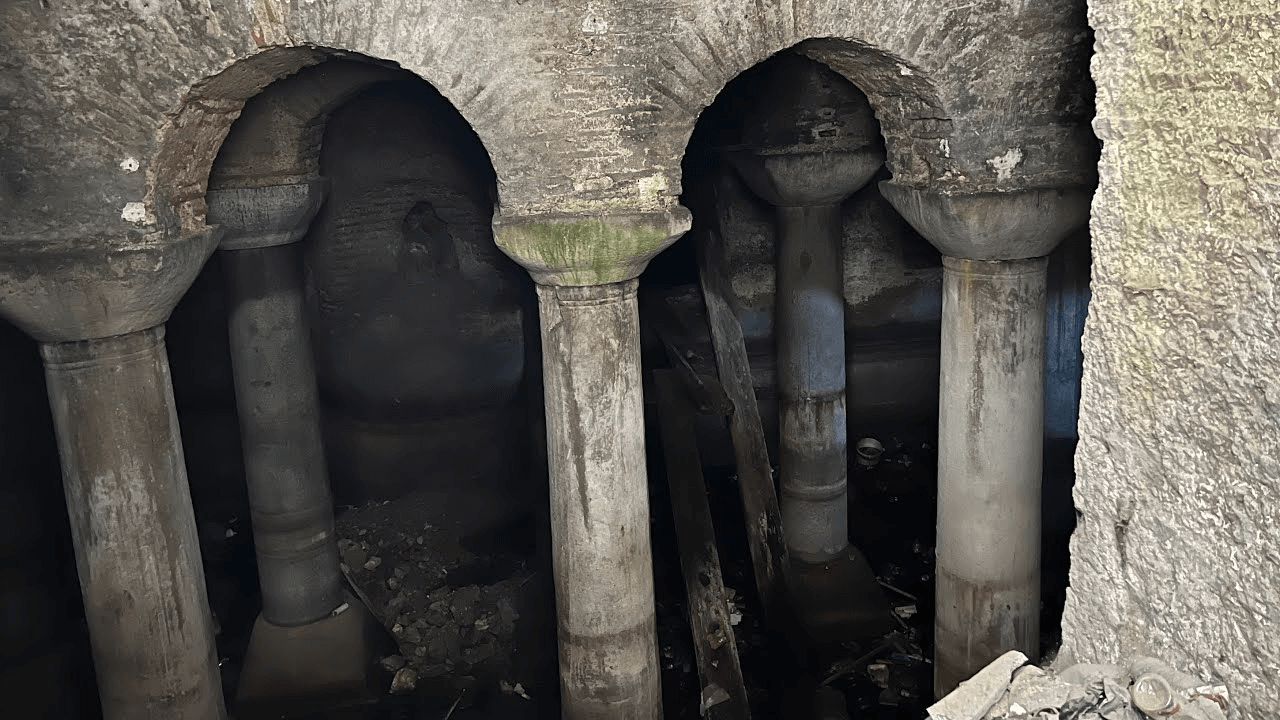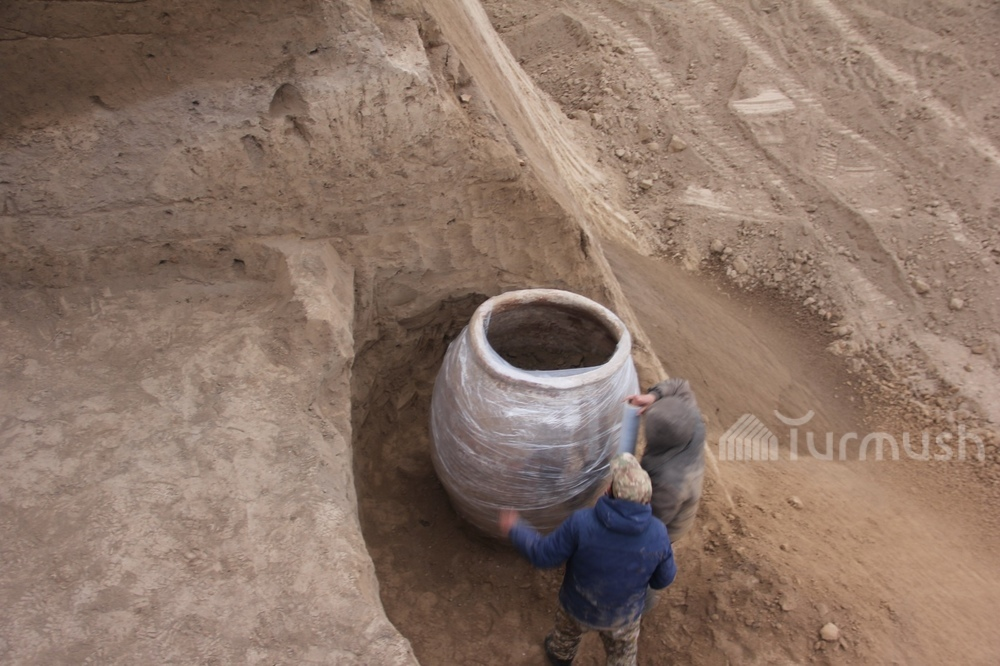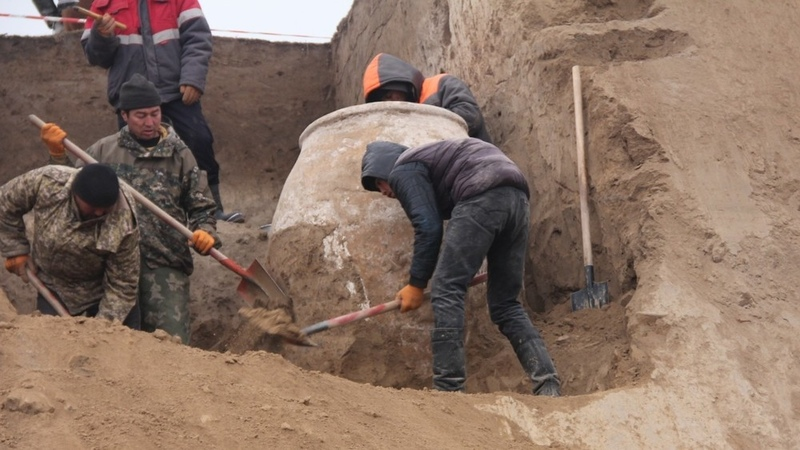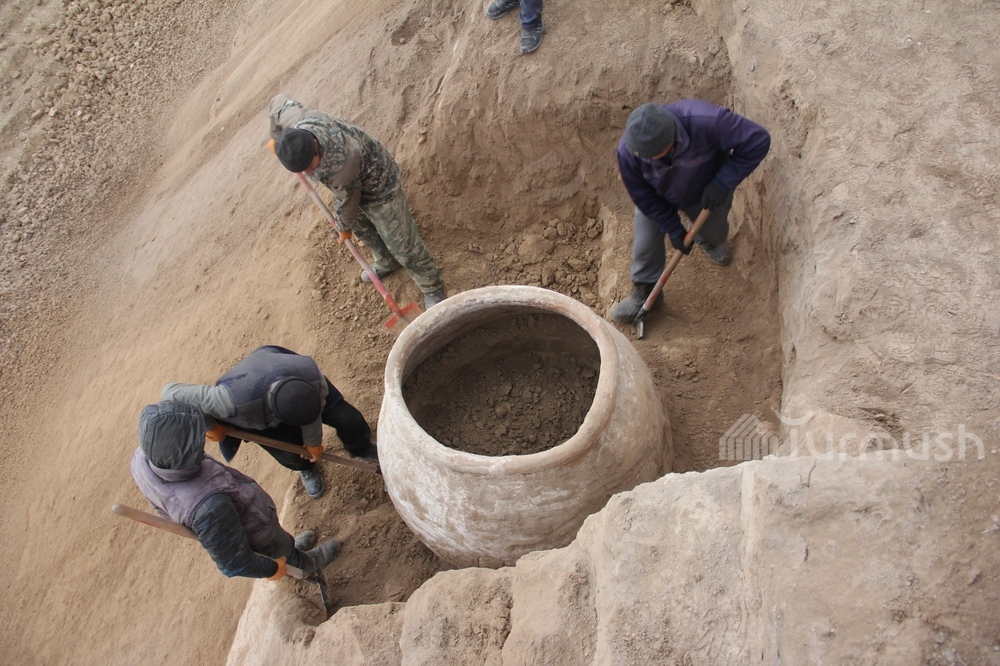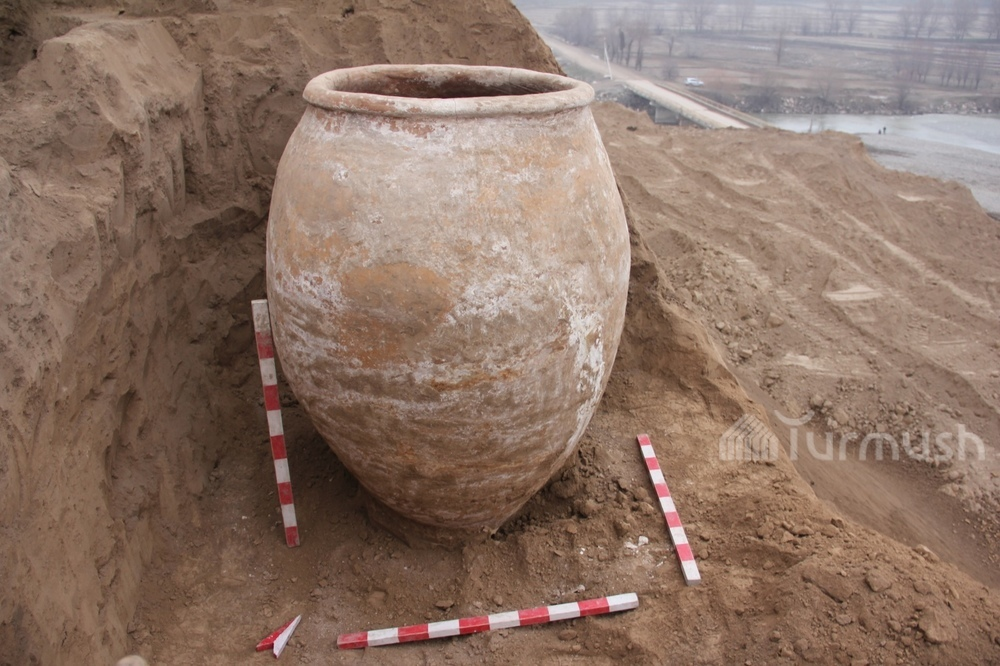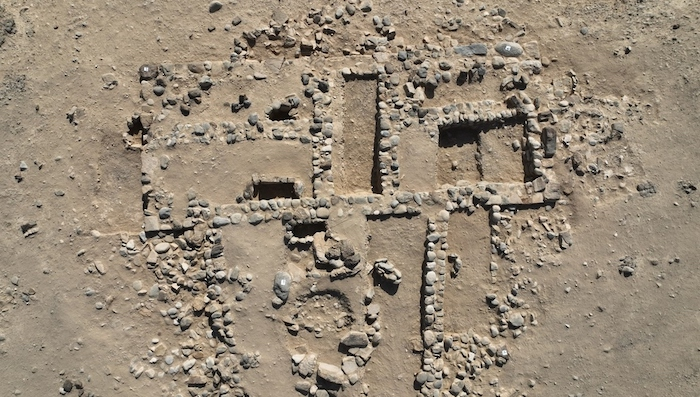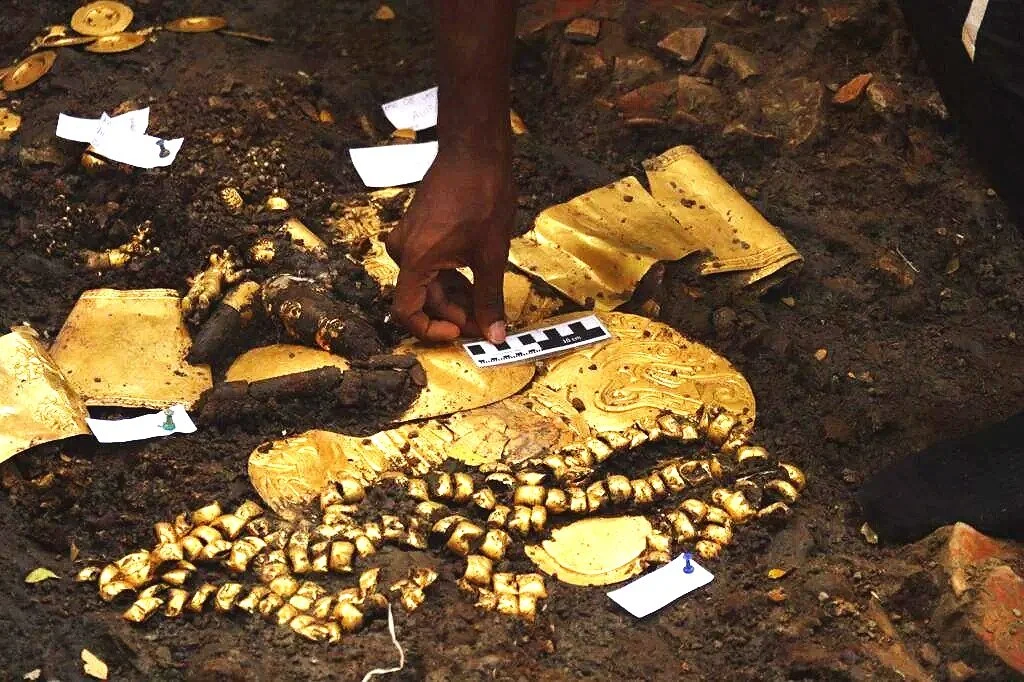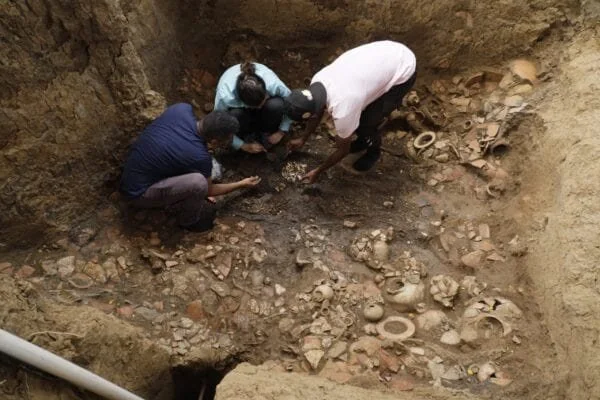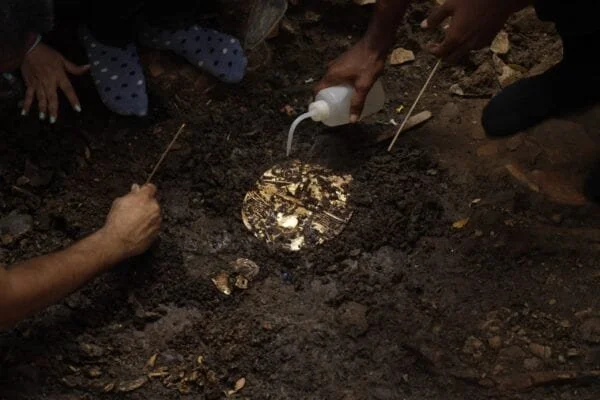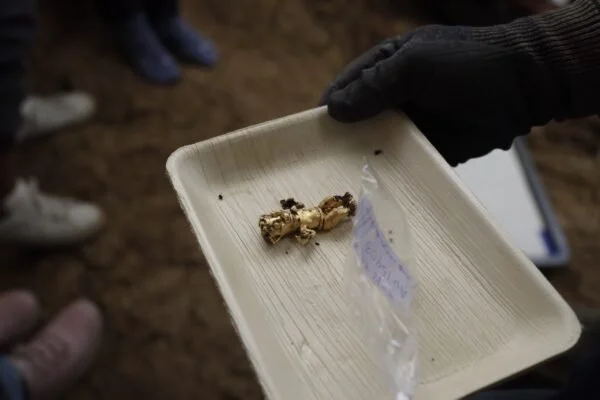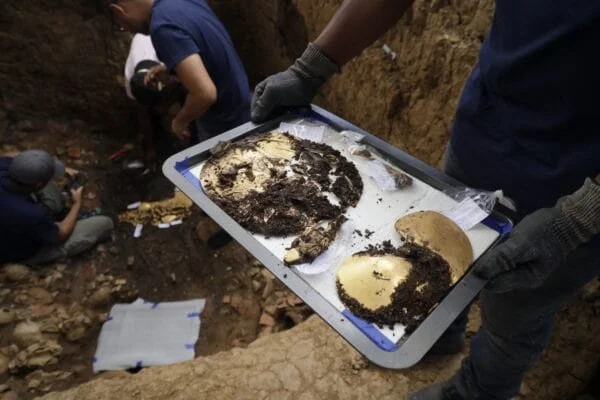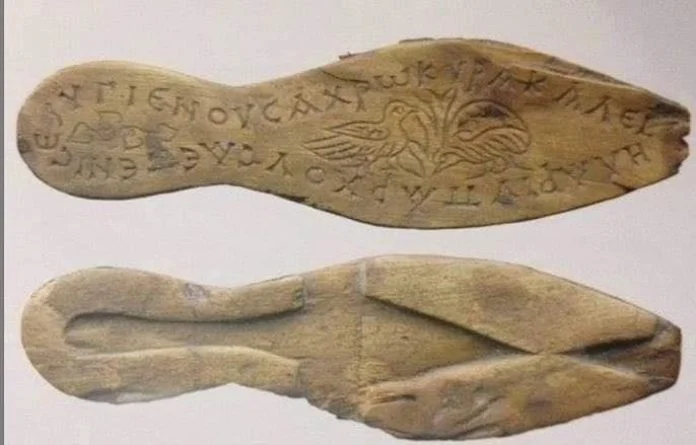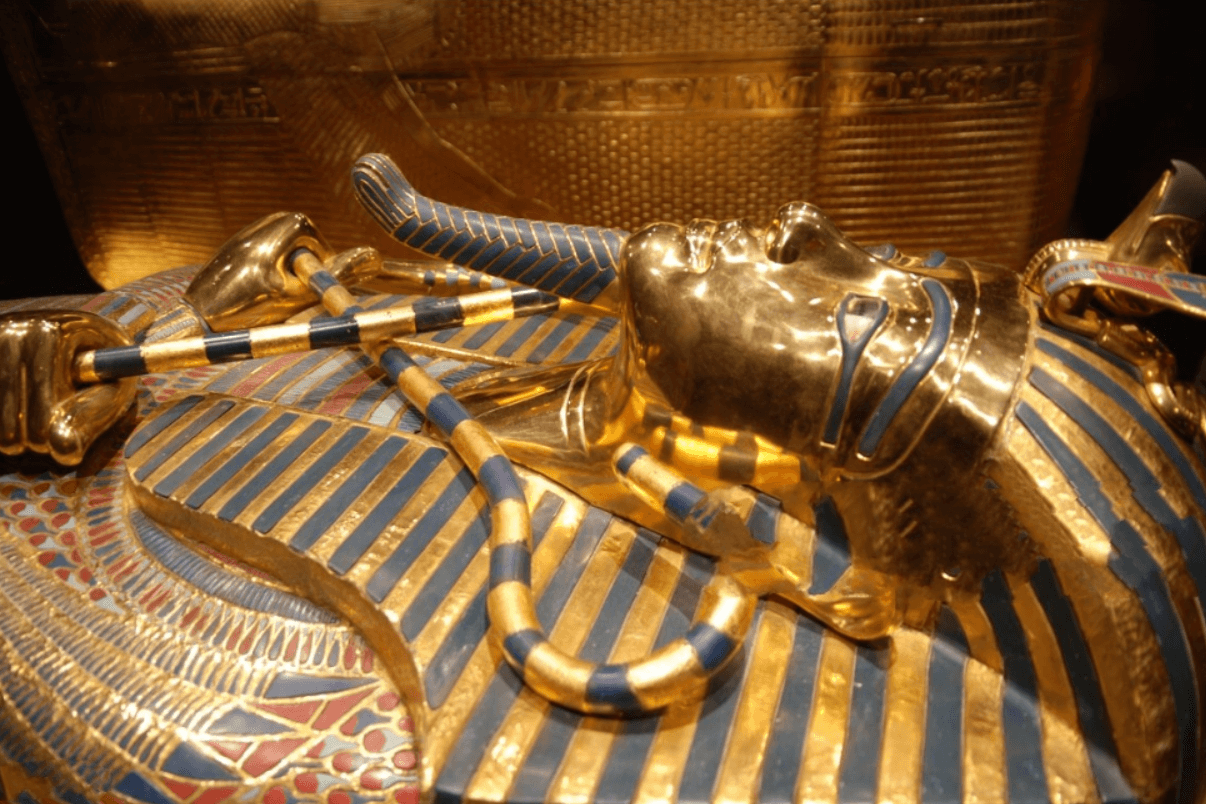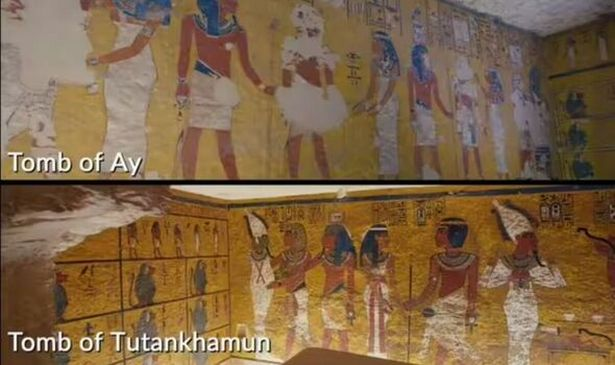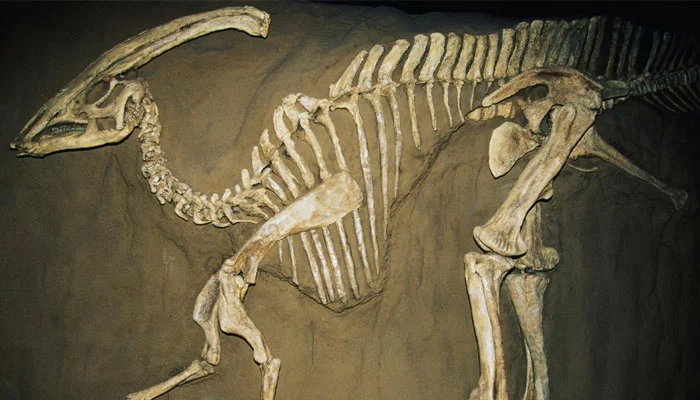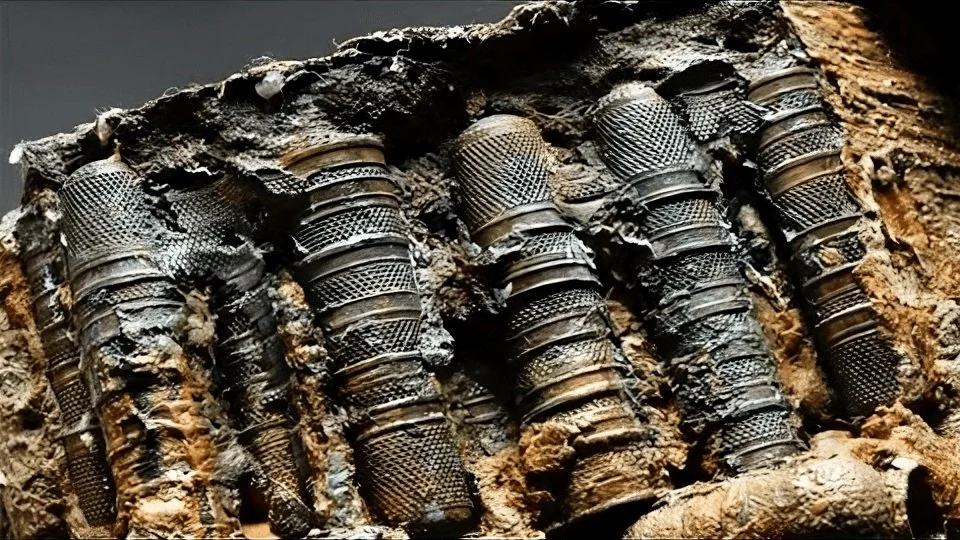Working in archaeology or paleontology must be an exciting and rewarding profession. There's always something new to discover, and in the process of making discoveries, you find out more about the world as it used to be. That knowledge allows historians to see the past in a new light and can totally change the way we think about the past! The past few years have been especially busy for those in the digging-and-discovering trade, and here are just a few of their most exciting finds.
Prehistoric Oasis Found With Drone and Google Earth
In this captivating video, we embark on an adventurous journey with Andrew, a Desert Drifter, as he navigates the rugged and treacherous terrain of the Labyrinth of Canyons in the American Southwest, in search of remnants from an ancient civilization.
Armed with determination and months of meticulous planning using Google Earth, Andrew sets out on his latest expedition, equipped with only his hiking shoes and a trusty drone as his scout. Despite a momentary lapse in preparation, he presses forward, undeterred by the challenging landscape that lies ahead.
As Andrew traverses the labyrinthine canyons, his nerves are put to the test, especially when faced with unexpected obstacles like a 5ft vertical section. With a mix of courage and caution, he conquers each hurdle, ascending to new heights and uncovering hidden wonders along the way.
Amidst the rugged terrain and fleeting moments of uncertainty, Andrew finds solace in the natural beauty surrounding him, from the tranquil potholes brimming with water to the surreal rock formations that dot the landscape like ancient sentinels.
Yet, even in the solitude of the desert, Andrew's senses remain sharp, a fleeting sense of unease washing over him as he feels a presence lurking in the shadows. However, a chance encounter with a butterfly brings a moment of respite, reminding him of the delicate balance between fear and wonder in the vast expanse of nature.
As the expedition draws to a close, Andrew reflects on his journey with a sense of fulfillment, knowing that each step taken has brought him closer to unraveling the mysteries of the desert. However, lingering doubts creep in, as he ponders whether his audience shares his passion for exploration or if they are growing weary of his adventures.
Nevertheless, Andrew remains undeterred, fueled by an insatiable curiosity and a deep-seated connection to the untamed wilderness that beckons him ever onward into the unknown.
Divers Discover 2000 Year Old 'Computer' That Is Rewriting History
In this captivating video, we delve into the remarkable discovery made by a team of divers that is reshaping our understanding of history: a 2000-year-old 'computer' found amidst the depths of the Aegean Sea.
The year is 1900, and a Greek sponge-diver embarks on a routine expedition, only to stumble upon an ancient shipwreck instead of the usual sponges. Little did he know, this serendipitous encounter would unveil a treasure trove of ancient artifacts, each offering a glimpse into the distant past.
Among these discoveries lies a lump of metal, weathered and encrusted with the debris of two millennia. What sets this artifact apart is its intricate design and mysterious functionality, resembling a primitive form of a computer. This unexpected find challenges our preconceived notions of ancient technology and sophistication.
As archaeologists and historians unravel the secrets of this ancient 'computer,' they are confronted with questions that defy easy answers. How did such a sophisticated device come to exist in an era widely considered technologically primitive? What purpose did it serve, and who were the minds behind its creation?
The discovery of this ancient 'computer' serves as a poignant reminder of the boundless ingenuity of humanity throughout the ages. It forces us to reevaluate our understanding of ancient civilizations and their capabilities, opening new avenues for exploration and discovery in the annals of history.
FORBIDDEN ARCHEOLOGY | 5 Archaeological Artifacts That Shouldn't Exist!
In this intriguing video, we embark on a journey through the realms of forbidden archaeology, delving into five captivating artifacts that challenge conventional narratives of ancient civilizations. Among these enigmatic relics are the London Hammer, the Genetic Disc, the Disk of Phaistos, the Quimbaya artifacts, and the Nails from Prehistory, each shrouded in mystery and speculation.
The London Hammer, a perplexing metal object encased in rock, raises questions about its origins and purpose. Similarly, the Genetic Disc, adorned with intricate patterns, hints at advanced knowledge beyond its time. The Disk of Phaistos, with its undeciphered symbols, captivates the imagination with its enigmatic messages from the past. The Quimbaya artifacts, crafted with remarkable precision, challenge our understanding of ancient metallurgy and craftsmanship. Lastly, the Nails from Prehistory, unearthed in unexpected contexts, invite speculation about their creators and their technological prowess.
These artifacts provoke profound questions about the capabilities of ancient civilizations. Were they far more advanced than traditionally believed, possessing knowledge and technologies that have since been lost or forgotten? Or do these artifacts suggest the influence of extraterrestrial beings, sparking theories of ancient contact with aliens?
The mismatch between the artifacts' dating and the prevailing historical timeline compels us to reconsider our understanding of the past. Could it be that our history extends much further back than previously thought, encompassing civilizations of astonishing sophistication and complexity?
As we contemplate these mysteries, we are reminded of the boundless potential of human ingenuity and the ever-expanding horizons of archaeological exploration. These artifacts serve as tantalizing glimpses into the depths of our shared history, challenging us to embrace the possibility of a past more extraordinary than we ever imagined.
Revealing the CHILLING SECRETS of the MAYAN CIVILIZATION
In this captivating video, we delve into the rich tapestry of the Mayan civilization, a marvel that emerged in the 3rd century BC within the vibrant landscapes of Mesoamerica. Unlike a monolithic empire, the Mayans flourished as a decentralized network of city-states, intricately woven together by trade alliances and occasional conflicts, each contributing to the mosaic of Mayan culture.
At the heart of Mayan society lay agriculture, with maize serving as both sustenance and symbol, fostering innovations in land management that laid the groundwork for their flourishing civilization. Through ingenious techniques like slash and burn agriculture and terracing, they transformed the landscape, cultivating bountiful harvests amidst the verdant embrace of nature.
But perhaps the most enduring legacy of the Mayans lies in their breathtaking architecture, a testament to their ingenuity and reverence for the natural world. Without the aid of metal tools, beasts of burden, or the wheel, they erected majestic cities adorned with intricate temples, palaces, and awe-inspiring pyramids. Each structure seamlessly integrated into the surrounding landscape, harmonizing with celestial alignments and topographical nuances.
The Mayans' mastery of astronomy was nothing short of extraordinary, enabling them to foresee celestial events with remarkable precision. Their sophisticated calendar system, a fusion of ritual and solar cycles, stands as a testament to their profound understanding of time and the cosmos.
In the realm of communication, the Mayans achieved another feat of innovation with the development of a complex writing system, a rare accomplishment in pre-Columbian Americas. Through this medium, they chronicled their history, beliefs, and scientific knowledge, leaving behind a legacy of wisdom for generations to come.
Furthermore, the Mayans demonstrated remarkable foresight in resource management, constructing elaborate water management systems to navigate the challenges of dry periods. Reservoirs, canals, and aqueducts bore witness to their ingenuity and commitment to sustainability.
Indeed, the legacy of Mayan architecture transcends the iconic pyramids, reflecting profound creativity and engineering prowess that continue to inspire awe and admiration to this day.
Hidden Ruins of Byzantine Constantinople
In the early 13th century, Constantinople, the majestic capital of the Byzantine Empire, stood as a beacon of wealth and grandeur, boasting a bustling population of 400,000 souls. Its core pulsated with life around the Great Palace, majestically overlooking the Hippodrome, while a stately avenue seamlessly connected it to the awe-inspiring Hagia Sophia and the illustrious forums of Constantine and Theodosius.
The city's landscape was a tapestry of opulence and functionality, with vast swathes dedicated to reservoirs, orchards, and vibrant market gardens. Amidst this splendor, the populace found their abodes nestled closer to the heart of the city, dwelling within the sanctity of churches and marble-clad mansions.
Yet, Constantinople's magnificence was not immune to the ravages of fate. Devastating fires scarred its streets, and the brutal Crusader sack of 1240 left wounds that time could not easily heal. Despite the efforts of Byzantine emperors, the city's once-proud edifices lay in disrepair, their grandeur fading into memory.
With the dawn of the Ottoman conquest in 1453, Constantinople entered a new era, becoming the cornerstone of an expanding Islamic empire. Much of its architectural splendor fell victim to the march of progress, dismantled to feed the hunger for building materials.
Nevertheless, whispers of medieval and ancient Constantinople still linger within the labyrinthine streets of modern Istanbul. Silent sentinels of a bygone era, honorific columns erected by Byzantine emperors, stand proud in public squares, such as the venerable column of Emperor Marcian and the majestic Anic column, anchoring the Forum of Constantine in time's embrace.
The Forum of Theodosius, once a testament to imperial grandeur, boasted a basilica, an awe-inspiring honorific column, and a triumphal arch, each bearing silent witness to the glory that once was Constantinople. Though time may have weathered its stones and history reshaped its destiny, the spirit of Constantinople lives on, echoing through the annals of time, forever etched into the fabric of Istanbul's storied past.
Ancient Egypt: The Final Years of Dynasty XXII
At the end of Dynasty XXII, Takelot I follows Osorkon I, but little is known about him. And then comes Osorkon II. They were powerful kings with great treasures. And what we’re going to see here is a little bit of a family feud. Osorkon II’s cousin, Harsiese, is made high priest at Karnak.
Mythological papyrus of Imenemsauf, Chief bearer of Amon. Detail: weighing of the soul before baboon god Thoth
UNSPECIFIED - CIRCA 1999: Egyptian civilization, Third Intermediate Period, Dynasty XXI-XXII. Mythological papyrus of Imenemsauf, Chief bearer of Amon. Detail: weighing of the soul before baboon god Thoth. (Photo By DEA / G. DAGLI ORTI/De Agostini via Getty Images)
Dynasty XXII and Alliance with Byblos & Isreal
Again, keeping it in the family. But what does Harsiese do? He declares himself king. So now you’ve got it again, two kings, northern and southern. But anyway, Harsiese dies, and what Osorkon II does is replaces Harsiese with his own son. So he’s consolidating it pretty quickly.
Now at this time, though, there is going to be a threat to these Libyan kings. Assyria is growing strong. Assyria, all the way to the north. And they’re marching south. They’re marching south. And something rather surprising happens. Egypt allies itself with Byblos and Israel and marches north, and stops the Assyrians on the Orontes River, far away from the border of Egypt. They don’t want them coming close. So at least for now, the Assyrians are moved out.
Egypt’s Wealth Kept Turmoil at Bay?
Now we have another king coming in: Takelot II, son of Osorkon II. And he maintains stability. Things are stable. He builds. And what we have to understand at this point is where this stability is coming from.
It comes from the wealth of Egypt. You see, even in times when Egypt is politically in distress and when there’s feuding, there are certain constants. The Nile is overflowing. It doesn’t matter what your politics do; that the Nile is going to overflow, and that the Nile is going to enable your peasants, your farmers, to grow crops. More crops than you need. You are going to have a surplus of crops because that’s the great thing about Egypt. They could always grow more crops than they needed.
That’s how you can afford to feed thousands of priests for the temples of Amun. And that’s how you can afford a standing army. So the peasants are going to be growing crops. And this surplus, you can trade for things like silver and gold. So there is a kind of wealth in Egypt that’s almost impossible to kill. When Egypt was in turmoil, people were always interested in it. It was still wealthy. So during Takelot II’s reign, there was a kind of stability of wealth.
But during his reign, there was a civil war. It lasts for nearly 10 years, back and forth. People want wealth within the family, perhaps. So there is battling. Real battling. There is one kind of rebellion where Takelot moves quickly. Kills the leaders. He doesn’t just kill them, though; that’s not enough. He burns their bodies as a statement. No chance of immortality. Remember, Egyptians are resurrectionists. If you don’t have your body, you’re not going to get up and go to the next world. So he burns their bodies. It’s a kind of brutal display of “don’t mess with me.”
Was Dynasty XXIII a Threat to the Dynasty of Bubastis?
Anyway, the civil war continues. There are problems at the end of this dynasty. And we even have a group of people popping up at another Delta city, Leontopolis. “Lion City.” Now it’s important to remember that this is also in the Delta. These people are ruling from Bubastis in the Delta, and now we don’t have faraway kings claiming they’re kings. We have almost next-door neighbors in the Delta. And this is a competing dynasty, the XXIIIrd, minor nobodies. But they take names after the great kings, like Sheshonq and Osorkon.
So we have this kind of spurious dynasty, Dynasty XXIII, ruling in the Delta. They’re not ruling much. They’re just putting their names in cartouches, calling themselves kings. And Dynasty XXII, the real dynasty, the dynasty of Bubastis, ends with Osorkon IV. It ends with him saying, “I am king of all Egypt.” And it ends with a few of these minor kings of the other dynasty claiming that they are kings.
So in a sense, it began by unifying with the Libyans, but it ended with a little bit of divisiveness. They did great things for 200 years. But it ends again with a little bit of a division. But again, Egypt was going to be united once again, but this time by people who were very closely tied to the Egyptians.
Common Questions about the Final Years of Dynasty XXII
Q: How did Egypt remain stable during the crises of Dynasty XXII?
Egypt was blessed with unbeatable wealth. Regardless of political conditions, the Nile always overflowed, resulting in a constant surplus of crops. This surplus could be used to trade many things. No matter what political turmoil occurred during the Dynasty XXII, Egypt remained stable.
Q: How did Takelot convey his message during the civil war of Dynasty XXII?
During the civil war of the Dynasty XXII Takelot kills the rebels and burns their bodies. For the Egyptians, who believe in resurrection, this is an important message. It means that there is no body left for these rebels to carry into the next world. In a way, this was Takelot’s way of warning his enemies.
Q: How did Dynasty XXII and Dynasty XXIII co-exist?
The Dynasty XXII and XXIII were rivals. The Dynasty XXIII claimed the right to the crown but had neither power nor military importance. So this became a minor feud between the two dynasties for a few years until the next dynasty arose.
A significant ancient large clay pot was unearthed undamaged near an ongoing road construction site in Uzgen.
During recent archaeological excavations in the Uzgen district of the Osh region, a significant discovery has emerged: a towering clay vessel known as a 'hum,' standing at an impressive height of 1.75 meters. Turarbek Abdyrahmanov, a member of the archaeological team representing the National Academy of Sciences of the Kyrgyz Republic, unveiled this remarkable find.
Under the leadership of Mars Boranbaev, the excavation efforts commenced just 5-6 days prior. On March 1, amidst the careful excavation process, the 'hum' surfaced from the depths, nestled 2.5 meters below ground level. Believed to hail from the 7th to 4th centuries BCE, this artifact remained remarkably intact as it was delicately extracted and transported to the Uzgen Architectural and Archaeological Museum.
"After meticulous cleaning, the 'hum' now awaits further examination as part of our ongoing research endeavors," Abdyrahmanov elaborated. "Already, fragments of clay pottery indicative of the Shoro-Bashat culture have been unearthed, signaling the rich historical tapestry of the region."
Situated in proximity to the Kyzyl-Oktiabr area, where plans for a bypass road are underway, the excavation site holds immense historical promise. As Abdyrahmanov emphasized, the bustling activity near the old city has spurred intensified archaeological exploration, with hopes of uncovering additional relics of antiquity. The 'hum,' towering at 1.75 meters in height and spanning 1.30 meters in width, serves as a testament to the ancient civilizations that once thrived in these lands.
Currently, the archaeological team comprises four dedicated experts and a workforce of 20, diligently unraveling the mysteries concealed beneath the earth's surface.
In tandem with these archaeological endeavors, construction on the Uzgen bypass road has been progressing steadily. Valued at 2.6 billion soms, the road project aims to alleviate traffic congestion in the area, offering a toll route designed for unidirectional travel. Spanning a length of 14.1 kilometers, plans for the bypass road include considerations for constructing either a four or six-lane thoroughfare.
As of the latest update on February 5, development efforts on five sections of the Uzgen bypass road remain underway, marking a harmonious blend of modern infrastructure projects and the preservation of ancient heritage.
Ancient structure for children's burial from the Iron Age unearthed in Oman.
A recent archaeological expedition led by the Department of Archaeology from Sultan Qaboos University in the Omani Peninsula unearthed a remarkable find: a children's funerary structure dating back to the Iron Age, approximately three thousand years ago, at the archaeological site 'Manaqi' in the Wilayat of Rustaq, South Al Batinah Governorate.
This discovery marks a significant breakthrough in comprehending funerary practices in the region, being the first dedicated children's funerary building discovered thus far. The excavation, conducted last February in collaboration with a team from Sorbonne University in Paris and under the Ministry of Heritage and Tourism's supervision, represents the inaugural season of a multi-year excavation project set to continue for at least five years.
The 'Manaqi' site, one of the largest Iron Age settlements in South Al Batinah Governorate, revealed numerous residential structures, extensive cemeteries, and defensive towers, indicating the settlement's prominence during the first millennium BC.
Among the excavated buildings, Building S2 stood out with its unique T-shaped design, housing over thirty graves exclusively for children, including infants. This departure from typical Iron Age funerary customs raises intriguing questions about the beliefs and motives behind this distinctive burial practice.
Dr. Mohammad Abdul Hamid Hussein, leading the research team and head of the Department of Archaeology at Sultan Qaboos University, highlighted the significance of the discovery. Excavations within the building unveiled additional rare artifacts, such as jars with basket-shaped handles and a pottery fragment adorned with a seal depicting two men, shedding light on previously unknown aspects of the region's history.
Dr. Hussein emphasized that this discovery opens new avenues for understanding Iron Age funerary rituals and religious beliefs in the Omani Peninsula, offering valuable insights into the cultural and social traditions of ancient societies in the region.
Stunning Find: Panama Unearths Significant Tomb Brimming with Gold and Ceramic Artifacts
A groundbreaking discovery has been made in the El Caño Archaeological Park in Panama, shedding new light on the sophisticated society of pre-Hispanic Coclé. This tomb, believed to belong to a Coclé lord from around 750 A.D., has unveiled a treasure trove of funerary offerings, including ceramic and gold artifacts.
The El Caño Archaeological Park, renowned for its necropolis of tombs and ancient monoliths dating back to 700–1000 A.D., has long been recognized for its historical significance. The recent excavation, part of an ongoing archaeological project initiated in 2022 through a cooperation agreement between the Ministry of Culture and the El Caño Foundation, has focused on thoroughly exploring Tomb No. 9.
The contents of the tomb, including pectorals, belts of gold beads, bracelets, earrings, necklaces, bells, and even a skirt made with dog teeth, speak volumes about the cultural and social wealth of Coclé society. Dr. Julia Mayo, director of the El Caño Foundation and leader of the archaeological project, emphasized the significance of this discovery, offering a glimpse into the life and death rituals of the Rio Grande chiefdom.
Of particular interest is the presence of sacrificial attendants buried alongside the lord, suggesting complex burial practices. The excavation process is ongoing, making it challenging to determine the exact number of individuals buried within the tomb. However, this type of burial, characterized by multiple and simultaneous burials, provides valuable insights into the beliefs and funerary customs of the Coclé society.
The tomb, constructed around 750 A.D., offers intriguing details, such as the lord's burial in a face-down position atop the remains of a woman, in accordance with customary practices of the culture. The El Caño Archaeological Park, established around 700 A.D. and abandoned by 1000 A.D., continues to yield significant archaeological discoveries, enriching our understanding of ancient Coclé society's funerary practices and cultural heritage.
The ancient sandals were discovered almost intact in the Istanbul dig. Credit: Twitter/@NkayaMuhittin
Ancient Greek Inscription on 1,500-Year-Old Sandals Unveils Sweet Message
In a remarkable archaeological discovery in Istanbul, a pair of women's sandals, dating back 1,500 years, has captured the attention of researchers and visitors alike. Unearthed during excavations linked to the Marmaray project, these sandals offer a poignant glimpse into Byzantine fashion and sentiment.
The most striking feature of these ancient sandals is the inscription in Greek adorning them. It reads, "Use in health, lady, wear in beauty and happiness," reflecting not only the practicality of footwear but also the wishes for well-being and joy expressed by the wearer or maker.
Believed to have belonged to a Greek woman, these sandals embody the fashion preferences of the Byzantine Empire. Known for their love of color and intricate patterns, Byzantines adorned their clothing and accessories with rich designs, showcasing their cultural sophistication.
Modesty was a prevailing cultural norm in Byzantine society, evident in the conservative styles of clothing. Despite the emphasis on covering up, the footwear discovered in the excavation project reveals a flair for ornamentation, with sandals, slippers, and boots adorned with elaborate decorations.
Of particular interest is the prevalence of red in women's footwear, a color often reserved for Imperial use in male shoes. This contrast highlights the nuanced gender dynamics and fashion choices of the time.
The excavation efforts, initiated in 2004, have yielded a wealth of historical artifacts, shedding light on Constantinople's vibrant past. With around sixty thousand artifacts currently housed in the Istanbul Archaeological Museum, these discoveries continue to enrich our understanding of Byzantine culture and civilization.
Beyond fashion, the excavations have unearthed significant archaeological finds, including the Harbor of Eleutherios and a vast collection of medieval sunken ships. These discoveries offer invaluable insights into Constantinople's role as a hub of trade and commerce in Late Antiquity.
Moreover, the excavation has revealed the oldest evidence of settlement in Constantinople, dating back to 6000 BC. Artifacts ranging from ancient footprints to pottery fragments provide a comprehensive view of the city's ancient origins and development over millennia.
As researchers continue to unravel the mysteries buried beneath Istanbul's surface, each discovery serves as a testament to the enduring legacy of the Byzantine Empire and its profound influence on the cultural heritage of the region.
Archaeologists are shocked by a chilling and previously unnoticed detail in Tutankhamun's death mask.
The discovery of an "overlooked feature" on Tutankhamun's iconic death mask has sent shockwaves through the archaeological community. Tutankhamun, famously known as the Boy King of Ancient Egypt, ruled for a mere decade before his untimely demise, yet his legacy endures as one of the most prominent figures of ancient history.
The golden funerary mask of Tutankhamun, now housed in the Egyptian Museum in Cairo, has long captivated scholars and enthusiasts alike. However, recent scrutiny by Professor Joann Fletcher, an esteemed Egyptologist from the University of York, has revealed a compelling revelation. While examining burial records meticulously maintained by British archaeologist Howard Carter at Oxford University's Griffith Institute, Professor Fletcher stumbled upon a detail previously overlooked by researchers - the presence of pierced ears on the death mask.
In an illuminating moment during the History Hit documentary, "The Valley Of Kings: The Egyptian Golden Age," Prof Fletcher shared her insights, stating, "It has been suggested that this mask was originally made for someone else. Research suggests that Tutankhamun would not have worn earrings beyond childhood. So, by the age of 20, when he died, he would not have been portrayed with pierced ears."
This revelation has led Prof Fletcher to propose a groundbreaking hypothesis: the possibility that the death mask was crafted for a different pharaoh altogether, potentially one with no direct relation to Tutankhamun. "This mask was not made for an adult male pharaoh," she noted, pointing out discrepancies in the gold used for the mask's face compared to the rest. "Evidence of soldering is clearly visible on the mask. It now seems as if Tutankhamun's own face was effectively grafted onto the mask of the previous ruler. They may have had pierced ears, they may have been a woman, it may well have been Nefertiti."
The enigmatic Queen Nefertiti, renowned for her influence during the Eighteenth Dynasty, emerges as a key figure in this intriguing narrative. Married to Akhenaten, Tutankhamun's father, yet not his mother, Nefertiti remains a subject of fascination and mystery. Speculation persists regarding her potential role in the events surrounding Tutankhamun's reign and burial.
Furthermore, insights from experts, such as Aliaa Ismail, shed light on the intricate dynamics of ancient Egyptian succession and burial practices. Ismail's observations in the "Lost Treasures of Egypt" documentary suggest a deliberate orchestration in the allocation of tomb contents, hinting at a strategic maneuver by Ay, Tutankhamun's successor, to claim a grander burial site for himself.
Tutankhamun's tomb compared to Ay's
As the mysteries surrounding Tutankhamun's death mask deepen, the legacy of Ancient Egypt continues to intrigue and inspire, inviting further exploration into its rich and enigmatic history.
The image shows the fossil remains of a 70 million-year-old titanosaur. — X/@OTC_SONG
A man keeps a Titanosaur fossil, which is about 70 million years old, hidden for over two years.
For over two years, Damien Boschetto, a Frenchman, harbored a remarkable secret: a 70-million-year-old titanosaur fossil he stumbled upon while walking his dog in Montouliers, near Herault, France. Concerned that the fossil might be disturbed or damaged, Boschetto chose to keep it concealed, confiding only in a local archaeologist friend.
Reflecting on the discovery, Boschetto recounted, "While walking the dog, a landslide on the edge of the cliff exposed the bones of various skeletons; they were fallen bones, therefore isolated. We realized after a few days of excavations that they were connected bones."
Eventually, Boschetto disclosed the find to the Cultural, Archaeological, and Paleontological Association in the nearby city of Cruzy. Subsequent analysis by researchers revealed the astonishing completeness of the fossil, estimated at 70%. Such intact dinosaur skeletons are exceedingly rare, making this discovery all the more remarkable.
To contextualize the rarity of such finds, a study suggests that despite an estimated 1.7 billion Tyrannosaurus rexes roaming the Earth between 66 million and 68 million years ago, scientists have uncovered fossils of fewer than 100 individuals.
Now, Boschetto's titanosaur fossil is destined for public display at the Cruzy Museum, joining another titanosaur femur discovered in 2012. Boschetto's passion for paleontology has been ignited by this experience; he departed from his career in the energy industry in September to pursue a master's degree in the field.
Deciphering the ancient scrolls of Herculaneum
Hidden beneath the ashes of Mount Vesuvius's devastating eruption in 79 AD lies the ancient city of Herculaneum, harboring a treasure trove: a library filled with precious papyrus scrolls. These scrolls hold the potential to unveil a wealth of Greek and Latin masterpieces, early Christian texts, and possibly the earliest references to Jesus himself. However, the volcanic fury that engulfed the city rendered these scrolls so fragile and charred that attempts to open them risked irreparable damage.
Yet, hope flickers anew with the advent of modern medical imaging technology. A team of three scholars, spearheaded by Brent Seales, a computer scientist hailing from the University of Kentucky, has embarked on a groundbreaking endeavor. Leveraging cutting-edge techniques such as CT scans and MRI, they aim to peer into the heart of these ancient scrolls without inflicting harm.
Seales, renowned for his prowess in digitally restoring medieval manuscripts, views the scrolls of Herculaneum as the pinnacle of challenge. Encased within a dense mass resembling charcoal, these scrolls taunt with their enigmatic contents, tantalizing scholars with the prospect of unlocking their secrets.
While the excavation site remains cloaked from public view, Massimo Osanna, the former custodian of Herculaneum and Pompeii, granted the 60 Minutes team exclusive access. Deep within the unexplored confines of the library, the tantalizing allure of undiscovered scrolls beckons, hinting at the untold stories and knowledge awaiting discovery.
Scripture BANNED From Book Of Daniel Reveal DISTURBING Knowledge About Human Excistence
Exploring the ancient scriptures of the Book of Daniel, we uncover a trove of wisdom in its lesser-known section: the Additions to Daniel. What profound mysteries await our discovery within these hallowed pages, particularly in the intriguing tale of Bell and the Dragon?
Set against the backdrop of King Joachim's reign in Judah, the narrative unfurls as Nebuchadnezzar, the formidable ruler of Babylon, lays siege to Jerusalem. Amidst the tumult of war, Nebuchadnezzar seizes sacred artifacts from the temple, including vessels wrought of gold and silver, deeming them spoils of conquest. In a further demonstration of his might, he charges his trusted eunuch, Ashpenaz, with the task of selecting the most brilliant and promising young men from among the captive populace of Jerusalem.
12 Most Amazing Ancient Artifacts Finds
In this video, we delve into the fascinating world of incredible artifacts and where they can be found. From ancient relics to modern marvels, incredible artifacts come in all shapes and sizes, spanning across cultures and continents.
There's no definitive criteria for what qualifies as an incredible artifact, but when you encounter one, it's undeniable. Whether it's a beautifully crafted piece of pottery, a meticulously carved sculpture, or a rare historical document, the allure of incredible artifacts is irresistible.
Our mission is to bring these remarkable artifacts to light and share their stories with you. Through informative and engaging videos like this one, we aim to showcase the diversity and richness of human history through the lens of these extraordinary treasures.
So sit back, relax, and join us on a journey as we explore the wonders of incredible artifacts from around the globe. We hope you enjoy the adventure!
JRE: Giant Hole Discovered In Greenland!
In this video, we delve into a recent groundbreaking discovery: an enormous crater in Greenland that provides compelling evidence of a comet impact during the last ice age. This crater, spanning a staggering 18 miles in diameter, remained hidden beneath layers of ice until its recent revelation.
Greenland, known for its vast ice cover, served as a crucial location for preserving evidence of ancient events. In 2013, researchers identified impact proxies, including nano diamonds, carbon spals, and platinum and iron traces in the ice dating back 12,800 years. These findings hinted at a significant cosmic event during the Younger Dryas period, lasting from 12,800 to 11,600 years ago.
The discovery of the crater amplifies the evidence for a comet impact during this period of global climatic upheaval. The Younger Dryas era witnessed a rapid decline in temperatures, rising sea levels, and the extinction of megafauna. Remarkably, the impact's repercussions extended worldwide, with traces found as far as Antarctica and Syria.
This cataclysmic event potentially obliterated an advanced civilization, reshaping the narrative of ancient history. It is speculated that the global flood, a prevalent tradition across cultures, might stem from collective memories of this devastating event rather than being merely mythological.
The unearthing of the crater and corroborating evidence aligns with the Younger Dryas Impact Hypothesis, shedding new light on our understanding of prehistoric events and their enduring impact on human civilization.
Megalithic Habitat Discovered on Google Earth
It sounds like you stumbled upon a fascinating archaeological site with ancient habitats built into the Earth in the American West. The discovery of such structures could indeed shed light on a once-thriving civilization that may have been impacted by climatic changes leading to drought and abandonment.
The presence of a sacred rock with a perfect north-facing orientation adds another layer of intrigue to the site, possibly indicating its significance to the local Indigenous people and their cultural practices.
As you explore further into this remote location and uncover unexpected findings, such as sources of life in desolate areas, it prompts questions about the nature of these structures and their purpose. Are they evidence of lost civilizations, or do they reflect unique geological and erosional processes? Could they even evoke comparisons to fictional places like the Shire from "The Lord of the Rings"?
The rich Native American heritage of the area adds depth to your exploration, highlighting the importance of preserving and respecting these cultural legacies amidst modern influences.
Your curiosity and willingness to seek expertise in understanding the significance of these habitats demonstrate a commendable effort to uncover the mysteries of the past. Through continued research and collaboration with experts, you may gain further insights into the history and significance of this intriguing archaeological site.
Ancient Forebear to a Holy Visage: The 'Madonna of Aigai' and Byzantine Art
The "Madonna of Aigai" is a remarkable artifact that not only offers insights into the artistic conventions of the time but also provides an intriguing link between the classical art of ancient Greece and the religious iconography that would later become a staple of Byzantine culture.
The Fresco: Madonna of Aigai
The fresco referred to as the "Madonna of Aigai" hails from the Royal Macedonian Tomb at Aigai, located in Central Macedonia, Greece. Dated to the 4th century BC, this work is contemporaneous with the tumultuous period following the death of Alexander the Great and the subsequent division of his empire. The art of this era, known as the Hellenistic period, was characterized by increased expressiveness and dynamism, with a shift towards representing emotional intensity and realism in human figures.
The fresco itself is an enigmatic piece. While it is known as the "Madonna of Aigai," this title is a product of modern interpretation rather than an ancient designation. The figure depicted bears a striking resemblance to Christian images of the Virgin Mary, which were produced over a millennium later. This resemblance is particularly astounding given the secular nature of Greek art in the 4th century BC, which would not have depicted biblical figures.
The so-called “madonna” of Aigai. Detail from the grave stele of a woman, second half of 4th century BC
Evolution from Classical and Hellenistic Art to Roman and Byzantine Art
The transition from classical and Hellenistic art to Roman and subsequently Byzantine styles was neither abrupt nor homogeneous. Classical Greek art, famed for its pursuit of idealized human forms and balanced proportions, evolved during the Hellenistic period to embrace more naturalistic and individualized expressions. This period is noted for its dramatic expressions, intricate compositions, and an interest in depicting the textures of different materials.
Due to Alexander's conquests, Greek culture spread throughout the Mediterranean, blending Hellenistic artistic influences with regional customs that the Roman Empire would later inherit. Roman art borrowed heavily from the Greeks while also contributing innovations such as a greater focus on individual portraiture and the extensive use of narrative relief in architecture.
With the rise of Christianity as the state religion of the Roman Empire and the eventual shift of the empire's center to Byzantium (later known as Constantinople), a new form of religious art began to emerge. Early Christian and Byzantine art was often less concerned with naturalism and more with conveying religious ideals and theological truths. Icons, characterized by their formalism and spiritual significance, became central to Byzantine worship.
Theotokos praying icon
Timeless Transitions: The 'Madonna of Aigai' as a Precursor to Byzantine Aesthetics
The "Madonna of Aigai" serves as a visual bridge between these eras. The fresco's style—particularly the figure's frontal stance, serene countenance, and the drapery's gold highlights—foreshadows the stylistic choices of Byzantine iconography. The frontal pose and direct gaze would become hallmarks of Byzantine religious figures, intended to engage the viewer in a direct and spiritual manner. The use of gold to accentuate the drapery recalls the opulence of Byzantine art, which often utilized gold to signify divine radiance.
However, the fresco still retains elements of Hellenistic artistry. The realistic depiction of the cloth's folds and the subtle modeling of the figure's face show a level of detail and naturalism that is characteristic of the Hellenistic style. This synthesis of styles suggests that while the iconography of the Byzantine era was distinct, it did not appear in a vacuum. Instead, it was the result of a complex process of cultural and artistic fusion that spanned centuries.
The "Madonna of Aigai" is a tantalizing piece that defies simple categorization. It encapsulates the transition from the world of ancient Greece, with its human-centered art, to the spiritually focused iconography of the Byzantine era. The fresco stands as a testament to the enduring and evolving nature of art, where styles and symbols of different eras can converge in a single piece, bridging the gap between past and present, secular and sacred.
Mystery of Vergina Tombs: New Research Sheds Light on Alexander the Great's Relatives
In the heart of northern Greece lies Vergina, a place shrouded in historical intrigue and significance. Home to the ancient city of Aigai, it served as the first capital of the Macedonian kingdom, bearing witness to the rise and fall of illustrious figures whose legacies continue to captivate scholars and enthusiasts alike. Among these luminaries, none looms larger in the annals of history than Alexander the Great, whose conquests reshaped the ancient world.
Recently, new research published in the Journal of Archaeological Science has reignited discussions surrounding the royal tombs of Vergina, offering fresh insights into the identities of those interred within. Spearheaded by archaeologists and bolstered by meticulous examination techniques, this study delves deep into the skeletal evidence unearthed from the hallowed grounds of Royal Tombs I, II, and III.
For decades, scholars have grappled with the enigma of Vergina's royal tombs, particularly regarding the occupants of each sepulcher. While it was widely acknowledged that these tombs housed the remains of individuals closely linked to Alexander the Great, the precise identities remained a subject of fervent debate. However, recent advancements in archaeological methodology, including macro-photography, X-ray analysis, and anatomical examinations, have provided a fresh lens through which to scrutinize the ancient bones.
Central to this groundbreaking study is the examination of Royal Tomb I, which yielded a treasure trove of skeletal remains, including those of a man, a woman, and an infant. Through meticulous analysis, researchers identified telltale signs consistent with historical accounts, notably the presence of knee fusion in the male skeleton—a characteristic associated with King Philip II of Macedonia, father of Alexander the Great. Moreover, the presence of a newborn infant aligns poignantly with the tragic narrative of Philip's assassination in 336 BC, mere days after the birth of his son.
In contrast, Royal Tomb II presented its own enigmatic tableau, housing the remains of a man and a woman. While some conjectured that this tomb might belong to Philip II himself, the absence of a newborn infant and the lack of evident physical trauma on the male skeleton cast doubt on this hypothesis. Instead, researchers posited that Tomb II likely entombs King Arridaeus, Alexander's half-brother, and his formidable warrior wife, Adea Eurydice. Skeletal evidence of extensive riding further reinforced this interpretation, offering a glimpse into the lives of these ancient Macedonian royals.
As the dust settles on this groundbreaking research, one thing remains abundantly clear: the royal tombs of Vergina continue to be a wellspring of historical revelation, offering tantalizing glimpses into the lives and legacies of Alexander the Great and his kin. Through the convergence of meticulous archaeological inquiry and interdisciplinary collaboration, the veil of mystery surrounding these ancient sepulchers is gradually lifted, illuminating the enduring legacy of one of history's most storied dynasties.






